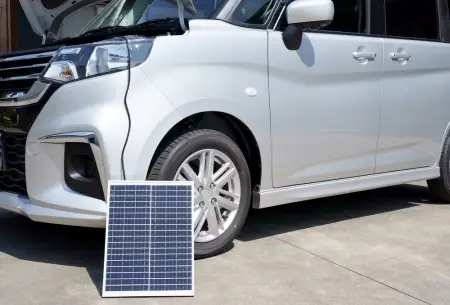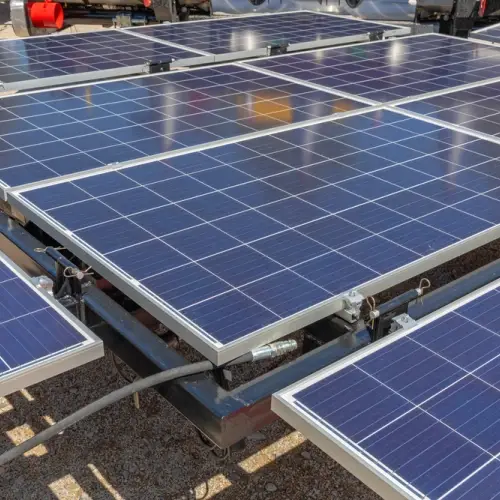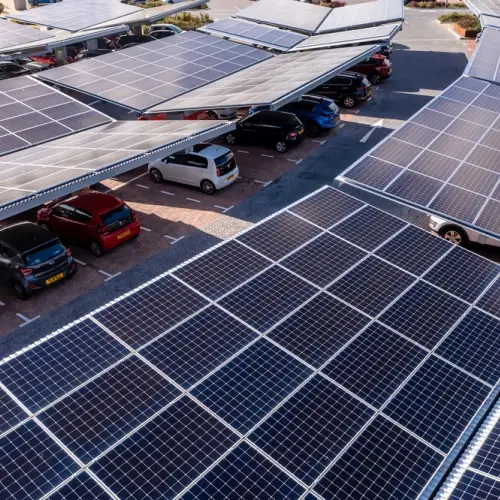
The concept of electric vehicles with integrated solar panels is an idea that has captured the imagination of many people. Imagine a car that can power itself, simply by absorbing sunlight while parked or even moving.
At first glance, this seems like a logical solution to supplement the power that electric vehicles already get from batteries, making the car more efficient and perhaps reducing the need to charge it frequently at charging stations. However, the reality is that most electric vehicles do not have solar panels, and the reasons behind this are more complex than you might think.
Below we will list the main reasons why electric cars have not yet massively adopted solar panels, despite the fact that this technology seems to be so aligned with sustainable mobility.
1. The limited size of solar panels on a car
 One of the main problems with integrating solar panels into electric vehicles is the limited surface size of a car.
One of the main problems with integrating solar panels into electric vehicles is the limited surface size of a car.
Solar panels are most effective when they cover large areas exposed to the sun for a long time. However, on a car, the amount of space available to install solar panels is relatively small. The top of the car, including the roof and perhaps the hood, does not offer enough surface area to generate a significant amount of power.
To put this into perspective, the power generated by a solar panel depends on factors such as the amount of sunlight available, the efficiency of the panel, and the area it covers. A typical car could house a solar panel system of around 300-500 watts, depending on the size of the vehicle. Under ideal conditions, these panels could generate about 2 to 3 kWh per day in a location with good sun exposure.
However, average electric cars require a battery with a capacity of between 50 and 100 kWh to operate properly, meaning that the energy generated by these solar panels would cover only a small fraction of the total energy needed by the car. In practice, it would be enough to travel only a few kilometres a day, far from what is required for longer trips or frequent use.
2. The limited efficiency of current solar panels
Another important reason is the efficiency of solar panels. Although solar technology has advanced significantly in recent decades, the efficiency of commercial solar panels is still relatively low. Most photovoltaic solar panels have an efficiency ranging from 15% to 22%. This means that only a fraction of the solar energy hitting the panel is converted into usable electricity.
While more efficient panels are constantly being developed, a level of efficiency that would make fully solar-powered cars viable has not yet been achieved. Under optimal conditions, a solar car equipped with the best solar panels on the market could generate enough power to extend its range by a few miles per day, but the majority of its power would still rely on conventional batteries.
Furthermore, it is important to remember that the efficiency of solar panels varies depending on weather and geographic conditions. On cloudy days or in areas with little direct sunlight, the amount of energy generated decreases dramatically. This would make solar vehicles even less practical in places where the climate is less favorable.
3. Cost and economic viability
 The cost of incorporating solar panels into electric vehicles is another key factor. Installing solar panels on a car can be expensive, both due to the materials and the integration technology. In most cases, the benefit in terms of energy obtained simply would not justify the additional expense for the manufacturer and the consumer.
The cost of incorporating solar panels into electric vehicles is another key factor. Installing solar panels on a car can be expensive, both due to the materials and the integration technology. In most cases, the benefit in terms of energy obtained simply would not justify the additional expense for the manufacturer and the consumer.
Solar panels require specialized infrastructure to be installed on the car, including additional electronics to manage the energy produced and store it efficiently. An energy management system is also required to harness the generated energy without overcharging the batteries or interfering with the car's electrical systems.
The cost of these systems, in addition to the panel itself, increases the total price of the vehicle. If we add to this the fact that the solar energy generated is minimal compared to the total needs of the car, the cost-benefit ratio is not favourable.
Car manufacturers currently prefer to invest in improving battery capacity and performance, which provides more value in terms of range and efficiency.
4. Additional weight and car efficiency
Electric cars are designed to be as light and aerodynamic as possible in order to maximise their efficiency and range. The addition of solar panels could increase the weight of the car, reducing the overall efficiency of the vehicle.
Although solar panels are not extremely heavy, all the additional equipment needed to integrate them (support structures, wiring, inverters, power control systems, etc.) increases the overall weight of the car. In an electric car, any additional weight directly affects the range, as more energy is needed to move the car.
Adding solar panels could therefore offset some of the benefits expected from the energy generated, making the car less efficient overall.
5. Mobile solar panels and the angle of the sun
 A crucial aspect of solar panel efficiency is their orientation and exposure to the sun. Fixed solar panels, such as those found on rooftops or large installations, are generally optimally oriented to capture the most sunlight possible throughout the day.
A crucial aspect of solar panel efficiency is their orientation and exposure to the sun. Fixed solar panels, such as those found on rooftops or large installations, are generally optimally oriented to capture the most sunlight possible throughout the day.
In contrast, solar panels installed on cars would be constantly in motion, meaning their exposure to sunlight would be less predictable and, in many cases, suboptimal.
If a car is moving, the solar panels are likely not to be in the ideal position to receive direct sunlight much of the time, which would reduce their ability to generate energy. Even when the car is parked, the orientation of the vehicle will not always be optimal to maximize sunlight capture.
This is especially problematic in urban areas where cars are often parked in garages, shadows of buildings or trees, further limiting sun exposure.
6. Limitations on the viability of solar vehicles
Although some companies, such as Lightyear, are developing vehicles with integrated solar panels, these models still face significant limitations. For example, the Lightyear One can generate enough power to travel only 50 to 70 kilometers on a sunny day, which is far from sufficient for the daily needs of most drivers. This shows that, despite advances, solar panels cannot be the primary source of energy for the propulsion of electric vehicles.
Furthermore, solar panels tend to be seen as more of an add-on than a comprehensive solution. They are primarily used to power auxiliary functions of the car, such as air conditioning or entertainment systems, suggesting that they are not up to the task of providing the power needed for driving. This further limits the rationale for integrating solar panels into electric vehicles, as their impact on the vehicle’s overall range remains minimal.
7. Stationary solar charging: a more viable option
 Integrating solar panels directly into electric vehicles faces serious limitations that make this option impractical. Rather than relying on panels on the car, solar charging stations represent a much more effective and efficient solution. These stations, which can be equipped with solar panels on their roofs and surrounding areas, can generate significantly more energy than the limited panels on a vehicle.
Integrating solar panels directly into electric vehicles faces serious limitations that make this option impractical. Rather than relying on panels on the car, solar charging stations represent a much more effective and efficient solution. These stations, which can be equipped with solar panels on their roofs and surrounding areas, can generate significantly more energy than the limited panels on a vehicle.
In addition, solar charging stations can be placed in optimal locations to maximize sunlight capture, something that is difficult to achieve in a moving car or parked in shaded locations. These facilities can also incorporate energy storage systems, allowing vehicles to be charged efficiently even in low-light conditions.
This type of infrastructure is not only more practical, but also allows for a scalable approach to increasing renewable energy use in transportation. In contrast, solar panels on cars face significant hurdles in terms of efficiency and energy output, making their deployment less viable compared to the option of charging at dedicated stations.